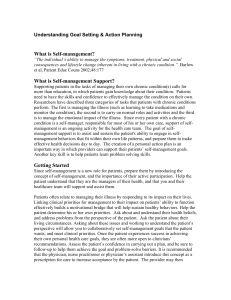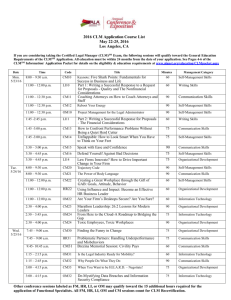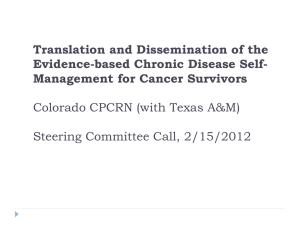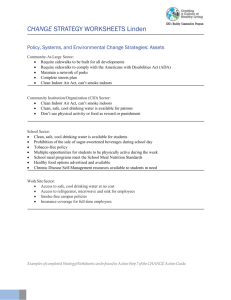Patient Self-Management
advertisement
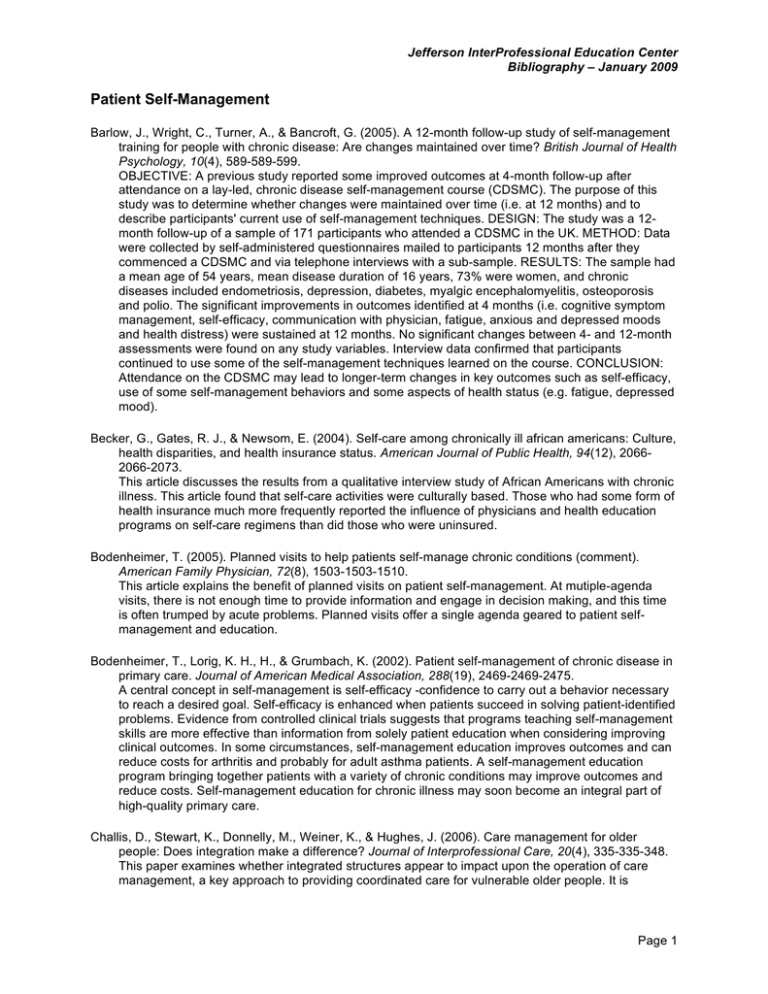
Jefferson InterProfessional Education Center Bibliography – January 2009 Patient Self-Management Barlow, J., Wright, C., Turner, A., & Bancroft, G. (2005). A 12-month follow-up study of self-management training for people with chronic disease: Are changes maintained over time? British Journal of Health Psychology, 10(4), 589-589-599. OBJECTIVE: A previous study reported some improved outcomes at 4-month follow-up after attendance on a lay-led, chronic disease self-management course (CDSMC). The purpose of this study was to determine whether changes were maintained over time (i.e. at 12 months) and to describe participants' current use of self-management techniques. DESIGN: The study was a 12month follow-up of a sample of 171 participants who attended a CDSMC in the UK. METHOD: Data were collected by self-administered questionnaires mailed to participants 12 months after they commenced a CDSMC and via telephone interviews with a sub-sample. RESULTS: The sample had a mean age of 54 years, mean disease duration of 16 years, 73% were women, and chronic diseases included endometriosis, depression, diabetes, myalgic encephalomyelitis, osteoporosis and polio. The significant improvements in outcomes identified at 4 months (i.e. cognitive symptom management, self-efficacy, communication with physician, fatigue, anxious and depressed moods and health distress) were sustained at 12 months. No significant changes between 4- and 12-month assessments were found on any study variables. Interview data confirmed that participants continued to use some of the self-management techniques learned on the course. CONCLUSION: Attendance on the CDSMC may lead to longer-term changes in key outcomes such as self-efficacy, use of some self-management behaviors and some aspects of health status (e.g. fatigue, depressed mood). Becker, G., Gates, R. J., & Newsom, E. (2004). Self-care among chronically ill african americans: Culture, health disparities, and health insurance status. American Journal of Public Health, 94(12), 20662066-2073. This article discusses the results from a qualitative interview study of African Americans with chronic illness. This article found that self-care activities were culturally based. Those who had some form of health insurance much more frequently reported the influence of physicians and health education programs on self-care regimens than did those who were uninsured. Bodenheimer, T. (2005). Planned visits to help patients self-manage chronic conditions (comment). American Family Physician, 72(8), 1503-1503-1510. This article explains the benefit of planned visits on patient self-management. At mutiple-agenda visits, there is not enough time to provide information and engage in decision making, and this time is often trumped by acute problems. Planned visits offer a single agenda geared to patient selfmanagement and education. Bodenheimer, T., Lorig, K. H., H., & Grumbach, K. (2002). Patient self-management of chronic disease in primary care. Journal of American Medical Association, 288(19), 2469-2469-2475. A central concept in self-management is self-efficacy -confidence to carry out a behavior necessary to reach a desired goal. Self-efficacy is enhanced when patients succeed in solving patient-identified problems. Evidence from controlled clinical trials suggests that programs teaching self-management skills are more effective than information from solely patient education when considering improving clinical outcomes. In some circumstances, self-management education improves outcomes and can reduce costs for arthritis and probably for adult asthma patients. A self-management education program bringing together patients with a variety of chronic conditions may improve outcomes and reduce costs. Self-management education for chronic illness may soon become an integral part of high-quality primary care. Challis, D., Stewart, K., Donnelly, M., Weiner, K., & Hughes, J. (2006). Care management for older people: Does integration make a difference? Journal of Interprofessional Care, 20(4), 335-335-348. This paper examines whether integrated structures appear to impact upon the operation of care management, a key approach to providing coordinated care for vulnerable older people. It is Page 1 Jefferson InterProfessional Education Center Bibliography – January 2009 concluded that further investigation is required as to the extent to which integrated structures have impacted upon patterns of professional working and underlying beliefs about roles. Chan, S., Siu, A., Poon, P., & Chan, C. (2005). Chronic disease self-management program for chinese patients: A preliminary multi-baseline study. International Journal of Rehabilitation Research, 28(4), 351-351-354. This study reports the preliminary findings on the effects of the Chronic Disease Self-management Program on a group of Chinese participants who suffered from chronic diseases. A total of 23 participants were recruited in a multi-baseline study protocol. Their self-management behaviors, selfefficacy and health status were captured over three baseline assessments and one post-test assessment. The results indicated significant increases in the performance of stretching exercises, the management of cognitive symptoms and communication with physicians. Their self-efficacy in terms of these aspects was found to be significantly increased. However, changes in other aspects of self-management which required more special skills and coordination with outside agencies were not significant. The changes in the physical and mental statuses of the participants were also not significant. It was observed that the positive effects of the program could be attributed to traditional Chinese beliefs of 'self-discipline' and a welcoming response towards self-efficacy strategies. Further studies should adhere to standards of a randomized clinical trial and further examine the mechanisms underpinning the changes in self-management behaviors among Chinese people with chronic diseases. Coleman, M. T., & Newton, K. S. (2005). Supporting self-management in patients with chronic illness (see comment). (review). American Family Physician, 72(8), 1503-1503-1510. This article reviews literature which discusses the support of patient self-management of chronic illnesses. This support includes: processes that develop problem-solving skills, self-efficacy, and the application of knowledge in real life situations that matter to patients. Emerging evidence supports the implementation of practice strategies that are conducive to patient self-management and improved patient outcomes among chronically ill patients. Darren, A., DeWalt, D., Pignone, M., Malone, R., Rawls, C., Kosnar, M. C., et al. (2004). Development and pilot testing of a disease management program for low-literacy patients with heart failure. Patient Education and Counseling, 55, 78-78-86. Randomized trials have shown that disease management programs can reduce hospitalizations and improve symptoms for patients with CHF. The authors sought to create and pilot test such a program for patients with low literacy skills. It was found that a heart failure disease management program designed specifically for patients with low literacy skills is acceptable and is associated with improvements in self-care behavior and heart failure related symptoms. Fu, D., Ding, Y., McGowan, P., & Fu, H. (2006). Qualitative evaluation of chronic disease selfmanagement program (CDSMP) in shanghai. Patient Education and Counseling, 61, 389-389-396. This study sought to explore the impact of a chronic disease self-management program on participants' perceptions of their behavior, health status, quality of life, and how the program achieves its benefits. In addition, the study explored how to collect suggestions for future improvement and dissemination of results. CDSMP was perceived to be effective to participants mainly through behavior change and self-efficacy development, though it had a few deficiencies. Goldstein, J. (2008, 02-13-2008). Helping patients help selves: Pa. panel aims to transform chronic-care delivery. Philadelphia Inquirer. Gray, J. A. (2004). Self-management in chronic illness. (comment). Lancet, 364(9444), 1467-1467-1468. This author comments on methods of providing patient education about chronic diseases, emphasizing the varied needs of patients even when dealing with the same disease. He states that individualization is the task of the primary care physician and proposes that this is a three step process and believes that this outlined method will become standard in primary care, as patients continue to seek more involvement in their treatment. Page 2 Jefferson InterProfessional Education Center Bibliography – January 2009 Grey, M., Knafl, K., & McCorkle, R. (2006). A framework for the study of self-and family management of chronic conditions. Nursing Outlook, 54(5), 278-278-286. The Yale School of Nursing has developed a framework to guide research efforts in interventions to enhance self- and family-management of chronic illness. Hall, P. (2005). Interprofessional teamwork: Professional cultures as barriers. Journal of Interprofessional Care, 19(Supplement 1), 188-188-196. Each health care profession has a different culture. As students progress throughout their education, common values from their respective professions are reinforced, which leads to increased specialization within each professional group. However, this specialization contributes to decreased interprofessional teamwork. Insight into the educational, systemic, and personal factors which contribute to the culture of the professions can help guide the development of innovative educational methodologies to improve interprofessional collaborative practice. Handley, M., MacGregor, K., Schillinger, D., Sharifi, C., Wong, S., & Bodenheimer, T. (2006). Using action plans to help primary care patients adopt healthy behaviors: A descriptive study. Journal of the American Board of Family Medicine : JABFM, 19(3), 224-231. PURPOSE: An action plan is an agreement between clinician and patient that the patient will make a specific behavior change. The goals of this study are to: determine whether it is feasible for patients to make action plans in the primary care visit; determine whether patients report carrying out their action plans; and describe the action plans patients choose. METHODS: Forty-three clinicians in 8 primary care sites were recruited to hold action-plan discussions with patients. Research assistants contacted patients by telephone 3 weeks later to assess whether patients had conducted their action plans. RESULTS: Eighty-three percent of enrolled patients (228) made an action plan during a primary care visit. Of the 79% who recalled making the action plan when interviewed by telephone 3 weeks later, 56% recalled the details of their action plan, and an additional 33% recalled the general nature of the action plan. At least 53% of patients making an action plan reported making a behavior change consistent with that action plan. CONCLUSIONS: Most patients reported making a behavior change based on an action plan, suggesting that action plans may be a useful strategy to encourage behavior change for patients seen in primary care. Hebert, K. A., Horswell, R. L., Dy, S., Key, I. J., Butler, M. K., Cerise, F. P., et al. (2006). Mortality benefit of a comprehensive heart failure disease management program in indigent patients. [The purpose of this study was to determine whether participation in a heart failure disease management (HFDM) program would reduce mortality in an indigent population from rural Louisiana. The study found that participation in an HFDM program was associated with decreased mortality compared with traditional follow-up care for this indigent population.] American Heart Journal, 151(2), 478-478-483. T Holman, H., & Lorig, K. (2004). Patient self-management: A key to effectiveness and efficacy in care of chronic disease. Public Health Reports, 119, 239-239-243. This article examines the role of the patient in their treatment of chronic disease. Jaber, R., Braksmajer, A., & Trilling, J. S. (2006). Group visits: A qualitative review of current research. Journal of the American Board of Family Medicine : JABFM, 19(3), 276-290. PURPOSE: The group visit model has emerged as one possible solution to problems posed by the limitations of current structures of care and the demands of a growing chronic illness load. In this article, we summarize current group visit research and develop suggestions for furthering this care model. METHODS: An electronic review of all group visit articles published from the years 1974 to 2004 was conducted via the PubMed and MedLine databases. Reference sections of articles thus obtained were mined for additional citations. Articles were excluded if: (1) they were not research studies (ie, purely descriptive, with no evaluative component); or (2) the group visit intervention was subsumed under larger primary or hospital-based interventions. RESULTS: Although the heterogeneity of the studies presented renders the assessment of this care model problematic, there is sufficient data to support the effectiveness of group visits in improving patient and physician Page 3 Jefferson InterProfessional Education Center Bibliography – January 2009 satisfaction, quality of care, quality of life, and in decreasing emergency department and specialist visits. CONCLUSION: Group visits are a promising approach to chronic care management for the motivated patient. Future research may benefit, however, from abandoning old nomenclatures and clearly defining the structure, processes of care, content of visits, and appropriate outcome measures. Lorig, K. (2003). Self-management education: More than a nice extra. Medical Care, 41(6), 699-699-701. Self-management education provides patients with the skills to live an active and meaningful life with their chronic conditions. This article looks at self-management interventions such as PRIDE. Lorig, K. (2006). Action planning: A call to action. JABFM, 19(3), 324-324-325. A commentary that examines the concept of action planning, or self-regulation. Lorig, K., Hurwicz, M. L., Sobel, D., Hobbs, M., & Ritter, P. L. (2005). A national dissemination of an evidence-based self -management program: A process evaluation study. Patient Education and Counseling, 59, 69-69-79. While evidence exists regarding the effectiveness of many health education interventions, few of these evidence-based programs have been systematically or widely disseminated. This paper reports on the dissemination of one such intervention, the 6-week-peer-led Chronic Disease SelfManagement Program, throughout a large health-care system, Kaiser Permanente. The authors describe the dissemination process and, using qualitative analysis of interviews and surveys, discuss the factors that aided and hindered this process and make recommendations for similar dissemination projects. Six years after the beginning of the dissemination process, the program is integrated in most of the Kaiser Permanente regions and is being offered to several thousand people a year. Lorig, K., Ritter, P. L., & Gonzalez, V. M. (2003). Hispanic chronic disease self-management. Nursing Research, 52(6), 361-361-369. This study aimed to evaluate the health and utilization outcomes of a 6-week community-based program for Spanish speakers with heart disease, lung disease or type 2 diabetes. At 4 months, the participants as compared with the usual-care control subjects, demonstrated improved health status, health behavior, and self-efficacy, as well as fewer emergency room visits. At one year, the improvements were maintained and remained significantly different from baseline condition. Lorig, K., Ritter, P. L., & Jacquez, A. (2005). Outcomes of border health Spanish/English chronic disease self-management programs. The Diabetes Educator, 31(3), 401-401-409. The purpose of this study was to evaluate the community based Chronic Disease Self-Management Program (CDSMP) and the Spanish-language version (Tomando control de su salud) programs as delivered in settings along the Texas/New Mexico border. The programs had proven effective in randomized trials, and the authors wished to determine if they would be as effective when administered by others to different populations. Participants showed improvements in health behaviors, health status, and self-efficacy at both four month and one year. Baseline self-efficacy and 4 month change in self-efficacy were significantly associated with improved one year outcomes. Lorig, K., Ritter, P. L., Laurent, D. D., & Fries, J. F. (2004). Long-term randomized controlled trials of tailored-print and small-group arthritis self-management interventions. Medical Care, 42(4), 346-346354. The objective of this study was to test the effectiveness of a mail-delivered, tailored selfmanagement interventions (SMART) and to compare it with the classic Arthritis Self-Management Program (ASMP). A mail-delivered arthritis self-management program SMART, was similarly effective to the classic ASMP, with slightly better results in the first year and a slightly more rapid attenuation over the next 2 years. Results suggest that both programs are effective, and that the addition of a mail-delivered program could improve accessibility to arthritis self-management treatment. Page 4 Jefferson InterProfessional Education Center Bibliography – January 2009 Lorig, K., Ritter, P. L., & Plant, K. (2005). A disease-specific self-help program compared with a generalized chronic disease self-help program for arthritis patients. Arthritis Rheumatology, 53(6), 950-950-957. Objective: Both the Arthritis Self-Management Program (ASMP) and the generic Chronic Disease Self-Management Program (CDSMP) have been shown to be successful in improving conditions in patients with arthritis. This study compared the relative effectiveness of the 2 programs for individuals with arthritis. Results: Both programs showed positive results. The disease-specific ASMP appeared to have advantages over the more generic CDSMP for patients with arthritis at 4 months. These advantages had lessened slightly by 1 year. Conclusion: The disease-specific ASMP should be considered first where there are sufficient resources and participants. However, both programs had positive effects, and the CDSMP should be considered a viable alternative. Lorig, K., Ritter, P. L., Stewart, A. L., Sobel, D. S., Brown, B. W., Bandura, A., et al. (2001). Chronic disease self-management program: 2-year health status and health care utilization outcomes. Medical Care, 39(11), 1217-1217-1223. This study sought to assess the 1-and2-year health status, health care utilization and self-efficacy outcomes for the Chronic Disease Self-Management Program (CDSMP). The major hypothesis was that during the 2-year period CDSMP participants would experience improvements or less deterioration than expected in health status and reductions in health care utilization. It was found that a low-cost program for promoting health self-management can improve elements of health status while reducing health care costs in populations with diverse chronic diseases. MacGregor, K., Handley, M., Wong, S., Sharifi, C., Gjeltema, K., Schillinger, D., et al. (2006). Behaviorchange action plans in primary care: A feasibility study of clinicians. Journal of the American Board of Family Medicine : JABFM, 19(3), 215-223. PURPOSE: Collaborative goal-setting--with clinician and patient together deciding on concrete behavior-change goals-may be more effective in encouraging healthy behaviors than traditional clinician-directed advice. This study explores whether it is feasible for clinicians to engage patients with coronary heart disease (CHD) risk factors in collaborative goal-setting and concrete action planning during the primary care visit. METHODS: Primary care clinicians were trained in goalsetting and action planning techniques and asked to conduct action plan discussions with study patients during medical visits. Clinicians' experiences were documented through post-visit surveys and with questionnaires and semistructured interviews at the end of the study. RESULTS: Fortythree clinicians and 274 patients with CHD risk factors participated in the study; 83% of the patient encounters resulted in a behavior-change action plan. Goal-setting discussions lasted an average of 6.9 minutes. Clinicians rated 75% of the discussions as equally or more satisfying than previous behavior-change discussions, and identified time constraints as the most important barrier to adopting the goal-setting process. CONCLUSIONS: Collaborative goal-setting between clinicians and patients for improved health behaviors is viewed favorably by clinicians in primary care. Time constraints could be addressed by delegating goal-setting to other caregivers. Rothman, R. L., DeWalt, D. A., Malone, R., Bryant, B., Shintani, A., & Crigler, B. (2004). Influence of patient literacy on the effectiveness of a primary care-based diabetes disease management program. Journal of the American Medical Association, 292(14), 1711-1711-1716. The purpose of this study was to examine the role of literacy on the effectiveness of a comprehensive disease management program for patients with diabetes. The study concluded that literacy may be an important factor for predicting who will benefit from an intervention for diabetes management. Szabo, J. (2007). Disease management. medicaid programs look outside to manage the chronically ill. Hospitals and Health Networks, 81(4), 18-18. Page 5 Jefferson InterProfessional Education Center Bibliography – January 2009 Warsi, A., Wang, P. S., LaValley, M. P., Avorn, J., & Solomon, D. H. (2004). Self-management education programs in chronic disease: A systematic review and methodological critique of the literature. Archives of Internal Medicine, 164(15), 1641-1641-1649. This article evaluated the efficacy of patient self-management educational programs for chronic diseases and critically reviewed their methodology. Self-management education programs resulted in small to moderate effects for selected chronic diseases. Page 6

